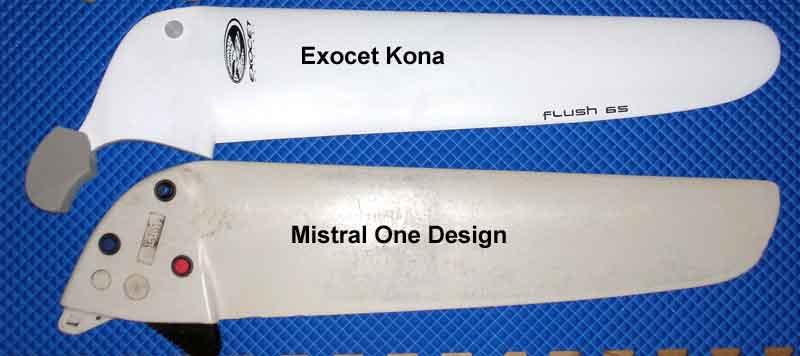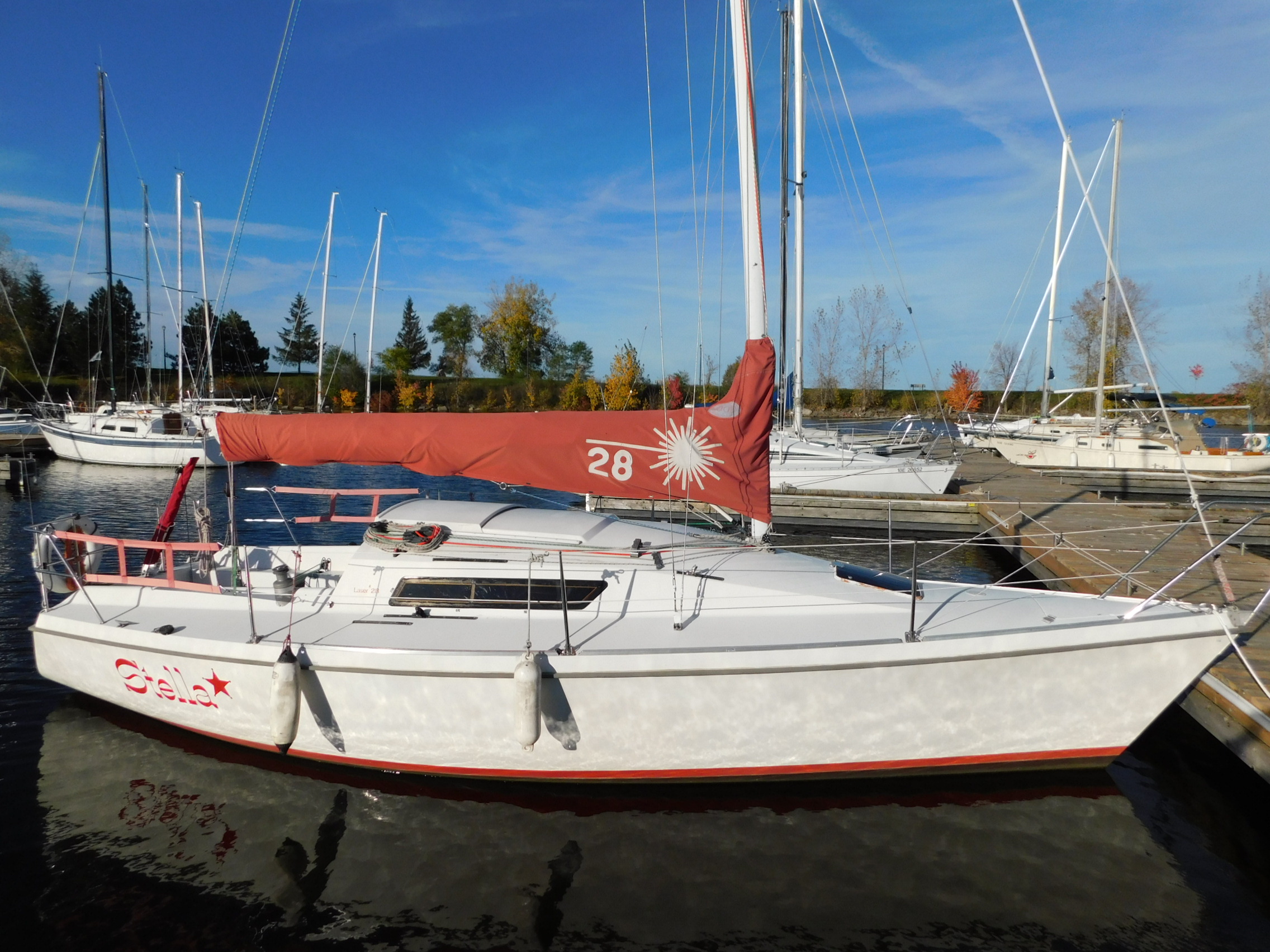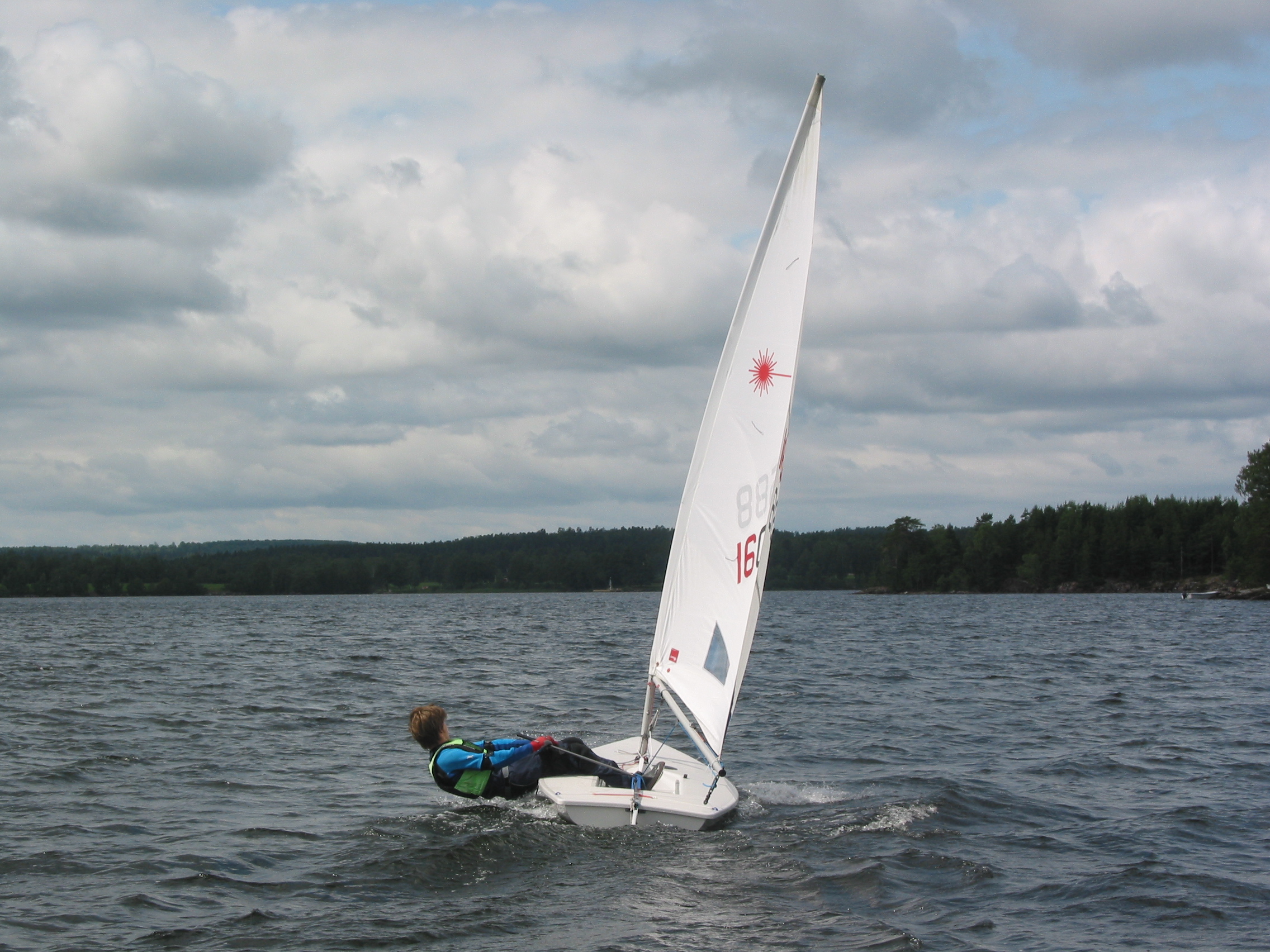|
Laser (sailboat)
The Laser is a class of single-handed, one-design sailing dinghies using a common hull design with three interchangeable rigs of different sail areas, appropriate to a given combination of wind strength and crew weight. Bruce Kirby designed the Laser in 1970 with an emphasis on simplicity and performance. The Laser is a widely produced class of dinghies. As of 2018, there were more than 215,000 boats worldwide. It is an international class with sailors in 120 countries, and an Olympic class since 1996. Its wide acceptance is attributable to its robust construction, simple rig and ease of sailing that offer competitive racing due to tight class association controls which eliminate differences in hull, sails, and equipment. The International Laser Class Association (ILCA) defines the specifications and competition rules for the boat, which is officially referred to as the ILCA Dinghy, due to a trademark dispute. Other "Laser"-branded boats of related designs include the Las ... [...More Info...] [...Related Items...] OR: [Wikipedia] [Google] [Baidu] |
Portsmouth Yardstick
The Portsmouth Yardstick (PY) or Portsmouth handicap scheme is a term used for a number of related systems of empirical handicapping used primarily in small sailboat racing. The handicap is applied to the time taken to sail any course, and the handicaps can be used with widely differing types of sailboats. Portsmouth Numbers are updated with data from race results, normally annually. The various schemes are not directly linked, and ratings for the same class can and often do vary in the different schemes. The most prominent Portsmouth Yardstick systems are probably those administered in the United States by the Portsmouth Numbers Committee, in the United Kingdom by the Royal Yachting Association ( RYA) and in Australia by Victoria Yachting. History The original UK Portsmouth Yardstick was developed by Stanley Milledge, who was in charge of handicapping racing at the '' Langstone Sailing Club'' in 1947 using the ''Island One'' design as the scratch boat (having a value 100). In 195 ... [...More Info...] [...Related Items...] OR: [Wikipedia] [Google] [Baidu] |
Daggerboard
A daggerboard is a retractable centreboard used by various sailing craft. While other types of centreboard may pivot to retract, a daggerboard slides in a casing. The shape of the daggerboard converts the forward motion into a windward lift, countering the leeward push of the sail. The theoretical centre of lateral resistance is on the trailing edge of the daggerboard. General A daggerboard is a removable vertical keel that is inserted through a "trunk" in the center of a vessel's hull, usually amidships. Daggerboards are usually found in small sailing craft such as day sailers, which are easily handled by a single person. Daggerboards are not usually ballasted but are locked in place by a clip or pin. Unlike a centreboard, which can be set at different angles to the hull of the boat, daggerboards are generally limited to a single perpendicular position relative to the hull. If a daggerboard is located off center, it is called a leeboard or a bilgeboard. The characteristic whi ... [...More Info...] [...Related Items...] OR: [Wikipedia] [Google] [Baidu] |
RS Aero
The RS Aero is a British sailing dinghy that was designed by Jo Richards as a one-design racer and first built in 2014. Production The design is marketed and distributed by RS Sailing of Romsey, United Kingdom. Design The RS Aero is a single-handed recreational sailboat, built predominantly of fiberglass. It has a cat rig, a raked stem, a vertical transom, a transom-hung rudder controlled by a tiller with a hiking stick extension and a retractable daggerboard. It displaces . The Aero can be fitted with one of three different rig and sail sizes to accommodate a range of sailors of different weights. Variants ;RS Aero 5 :This model was designed for children and small sailors and has of sail. ;RS Aero 7 :This model was designed for medium weight sailors and has of sail. ;RS Aero 9 :This model was designed for heavy weight sailors and has of sail. Operational history The design has won several awards, including the 2014 Paris Boat Show ''Coup de Coeurs'', the Netherlands 2 ... [...More Info...] [...Related Items...] OR: [Wikipedia] [Google] [Baidu] |
Impulse (dinghy)
The Impulse is an Australian sailing dinghy that was designed by Arthur Caldwell as a one-design racer and first built in 1975. Production The design was originally intended as a wooden boat for amateur construction, but has more recently been manufactured of fibreglass. In the past it was built by Tim Wilson Yacht Design, but that company is out of business. Today it is built by Formula Sailcraft (now known as the Dinghy Shop) in Williamstown, Victoria, Australia. Production started in 1975 and the type remains in production. Design The Impulse is a recreational sailboat, built predominantly of wood or fibreglass. It has a catboat rig, a raked stem, a vertical transom, a transom-hung rudder controlled by a tiller and a retractable centreboard. It displaces . The boat has a draft of with the centreboard extended and with it retracted, allowing beaching or ground transportation on a trailer or car roof rack. Operational history The boat is supported by a class club, ... [...More Info...] [...Related Items...] OR: [Wikipedia] [Google] [Baidu] |
Laser World Championships
The Laser World Championship have been held every year since 1974, organized by the International Sailing Federation. Laser (dinghy), Laser is an Olympic sailing classes, Olympic sailing class. Editions Medalists Multiple medallist See also *ISAF Sailing World Championships *Men's Laser Radial World Championships *Laser 4.7 World Championships References External linksSailing competitions from site Sports123.com (by Internet Archive) {{Sailing worlds Laser World Championships Recurring sporting events established in 1974 ... [...More Info...] [...Related Items...] OR: [Wikipedia] [Google] [Baidu] |
Laser 28
The Laser 28 is a Canadian-built sailboat designed by New Zealander Bruce Farr and first produced in 1984. Production The boat was built by Performance Sailcraft, the builder of the Laser dinghy, in Canada from 1984 until 1990, but it is now out of production. Production-level manufacturing was started in March 1984 and the first customer deliveries were made in October 1984 Early versions were hand-laid, while later ones were produced using a closed-mold process. The company specifically planned that the Laser 28 would be the sole keelboat offered and did not intend to produce a graduated line of boats, unlike other manufacturers at that time. Development The Laser 28's design started in 1978, following the success of the Laser dinghy, with the intention to produce a keelboat equivalent, for the Laser sailors who would outgrow the Laser, just need a keelboat as they aged, or for family cruising and racing. In 1980 Ian Bruce, president of Performance Sailcraft decided to ... [...More Info...] [...Related Items...] OR: [Wikipedia] [Google] [Baidu] |
Laser Stratos
The Laser Stratos is an all-round cruising and racing boat designed by Phil Morrison and built by LaserPerformance, the same company as the famous Laser Standard dinghy. It is built from fibre-glass and foam sandwich. The Laser Stratos comes in two forms, one with a keel (similar to most yachts) and one with a centreboard (like nearly all dinghies). The centreboard version is red and the keel version is blue. The Stratos is quite spacious and most of the rigging is kept out of the way. The boat can optionally be fitted with trapeze lines and an engine bracket for carrying an outboard engine. Dimensions The Stratos is long, its beam is and its mast height is . Special features The Stratos can be reefed in less than a minute to reduce the amount of power from the mainsail. The Stratos' Combi-Tec Mainsail includes short battens and a full-length top batten. The Stratos also has a furling jib, which means the Stratos can be fully depowered in less than ten seconds. Safety ... [...More Info...] [...Related Items...] OR: [Wikipedia] [Google] [Baidu] |
International Sailing Federation
International is an adjective (also used as a noun) meaning "between nations". International may also refer to: Music Albums * ''International'' (Kevin Michael album), 2011 * ''International'' (New Order album), 2002 * ''International'' (The Three Degrees album), 1975 *''International'', 2018 album by L'Algérino Songs * The Internationale, the left-wing anthem * "International" (Chase & Status song), 2014 * "International", by Adventures in Stereo from ''Monomania'', 2000 * "International", by Brass Construction from ''Renegades'', 1984 * "International", by Thomas Leer from ''The Scale of Ten'', 1985 * "International", by Kevin Michael from ''International'' (Kevin Michael album), 2011 * "International", by McGuinness Flint from ''McGuinness Flint'', 1970 * "International", by Orchestral Manoeuvres in the Dark from '' Dazzle Ships'', 1983 * "International (Serious)", by Estelle from '' All of Me'', 2012 Politics * Political international, any transnational organization of ... [...More Info...] [...Related Items...] OR: [Wikipedia] [Google] [Baidu] |
RS Tera
The RS Tera is a one-man monohull dinghy in the RS Sailing range of sailing boats. It is recognised by the International Sailing Federation (ISAF) as an international class, and is a popular boat for beginners and for children to race. Performance and design The RS Tera is suitable for introducing newcomers to the sport of sailing, but is also a good boat to race. The boat is highly robust, and it is built with a self draining cockpit and is easy to right after a capsize, in addition to which it has a floating daggerboard. The boat is fairly small and light, meaning it is possible to transport on a roof rack A roof rack is a set of bars secured to the roof of a motor car. It is used to carry bulky items such as luggage, bicycles, canoes, kayaks, skis, or various carriers and containers. They allow users of an automobile to transport objects on the ..., and that it is manageable on the water by younger children. The mast comes in two pieces, and the boom is padded. Furthermo ... [...More Info...] [...Related Items...] OR: [Wikipedia] [Google] [Baidu] |
Optimist (dinghy)
The Optimist is a small, single-handed sailing dinghy intended for use by young people up to the age of 15. The Optimist is one of the two most popular sailing dinghies in the world, with over 150,000 boats officially registered with the class and many more built but never registered. It is sailed in over 120 countries and it is one of only two sailboats as an International Class by World Sailing exclusively for sailors under 16. Origin The Optimist was designed in 1947 by American Clark Mills at the request of the Clearwater Florida Optimist service club following a proposal by Major Clifford McKay to offer low-cost sailing for young people. The Optimist Club ran a soap box derby, but wanted more than a single-day event. Thus they were looking for a low-cost equivalent for sailing. He designed a simple pram that could be built from two 4' x 8' sheets of plywood, and donated the plan to the Optimists. The design was slightly modified and introduced to Europe by Axel Damg ... [...More Info...] [...Related Items...] OR: [Wikipedia] [Google] [Baidu] |
Europe (dinghy)
The Europe is a one-person dinghy designed in Belgium in 1960 by Alois Roland as a class legal Moth dinghy. The design later changed into its own one-design class. The dinghy is ideal for sailors weighing 50–85 kilos. The hull is made of fibre glass and weighs 45 kg, fully rigged 60 kg. The dinghy is tapering in the stem and round in the bottom. The sail is made of dacron. The mast is made of carbon fibre and specially designed to the sailor. A soft mast is best for light sailors, while heavier sailors use stiffer masts. Sails are also specially designed according to mast stiffness and crew weight. The Europe was introduced as an Olympic class in the 1992 Summer Olympics as the women's single-handed dinghy. It was replaced by the Laser Radial in the 2008 Summer Olympics. Since 2008 the Europe is one of the Vintage Yachting Classes at the Vintage Yachting Games The Vintage Yachting Games are an international Quadrennial multi class sailing event for former O ... [...More Info...] [...Related Items...] OR: [Wikipedia] [Google] [Baidu] |
Laser Dinghy
The Laser is a class of single-handed, one-design sailing dinghies using a common hull design with three interchangeable rigs of different sail areas, appropriate to a given combination of wind strength and crew weight. Bruce Kirby designed the Laser in 1970 with an emphasis on simplicity and performance. The Laser is a widely produced class of dinghies. As of 2018, there were more than 215,000 boats worldwide. It is an international class with sailors in 120 countries, and an Olympic class since 1996. Its wide acceptance is attributable to its robust construction, simple rig and ease of sailing that offer competitive racing due to tight class association controls which eliminate differences in hull, sails, and equipment. The International Laser Class Association (ILCA) defines the specifications and competition rules for the boat, which is officially referred to as the ILCA Dinghy, due to a trademark dispute. Other "Laser"-branded boats of related designs include the Las ... [...More Info...] [...Related Items...] OR: [Wikipedia] [Google] [Baidu] |





